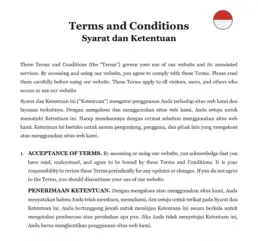Ready to use legal template
Drafted by experienced lawyers
Indonesian-English translation
Ready to use legal template
Drafted by lawyers
Indonesian-English translation
Home › Intellectual property › Terms and Conditions
Learn more about Website Terms and Conditions in Indonesia
In Indonesia, terms and conditions are a legal agreement that sets the rights and duties of parties involved in a transaction, service, or product usage. It lays out the rules, responsibilities, and restrictions that govern the relationship between the provider and the consumer. These terms and conditions can encompass various aspects, such as payment terms, delivery procedures, warranties, dispute resolution methods, intellectual property rights, and privacy provisions. These terms and conditions can cover various aspects, such as payment terms, delivery arrangements, warranties, dispute resolution procedures, intellectual property rights, and privacy provisions. Themis Partner offers you an easy to edit Terms and Conditions drafted by lawyers to comply with the law in Indonesia.
📄 Related documents
Table of contents
What are Terms and Conditions in Indonesia ?
Why use a Terms and Conditions?
What should it include under Indonesian law?
How does it protect businesses and consumers?
How does it outline intellectual property rights?
What are the consequences of non-compliance?
What if I don’t have a Terms and Conditions
What are Terms and Conditions in Indonesia?
Terms and conditions, often abbreviated as T&C, refer to the legal agreement that outlines the rules, obligations, and rights governing the use of a product or service. It is a document that establishes the terms under which individuals or entities may interact with a company, website, or application. Typically found on websites, mobile apps, or printed materials, terms and conditions cover various aspects, including user responsibilities, intellectual property rights, disclaimers, privacy policies, refund policies, and dispute resolution mechanisms. These terms serve to protect the interests of both the provider and the user by setting clear expectations and defining the boundaries of the relationship between them. Users are usually required to agree to the terms and conditions before they can access or utilise the product or service, ensuring a mutual understanding and agreement between the parties involved.
Why use Terms and Conditions?
Using T&C is essential for several reasons.
| ➤ Firstly, it establishes a legal framework that governs the relationship between a company and its users or customers. By clearly defining the rights, responsibilities, and obligations of both parties, it helps prevent misunderstandings and disputes. |
| ➤ Secondly, terms and conditions protect the interests of the company or service provider. It allows them to outline the acceptable use of their product or service, set limitations, and define liabilities. This helps safeguard their intellectual property, maintain the security of their systems, and mitigate potential risks. |
| ➤ Thirdly, terms and conditions can inform users about their rights, privacy policies, refund policies, and any disclaimers or limitations of liability. This transparency fosters trust and ensures that users are aware of the terms they are agreeing to. |
| ➤ Lastly, terms and conditions can serve as a legal defense in case of disputes, as they provide a written record of the agreed-upon terms and the user's acceptance of them. |




